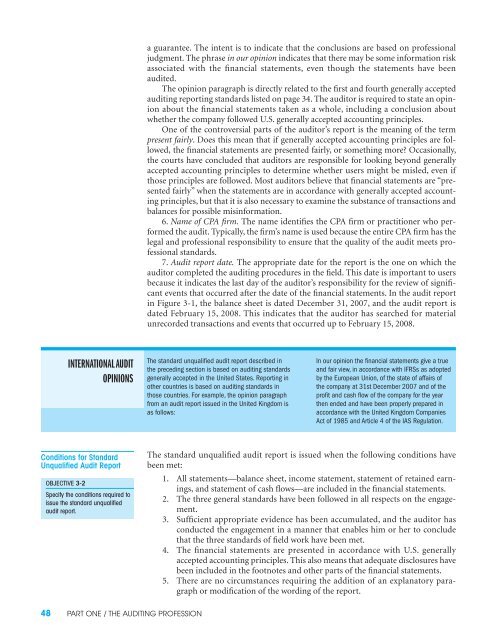audit reports
audit reports
audit reports
Create successful ePaper yourself
Turn your PDF publications into a flip-book with our unique Google optimized e-Paper software.
a guarantee. The intent is to indicate that the conclusions are based on professional<br />
judgment. The phrase in our opinion indicates that there may be some information risk<br />
associated with the financial statements, even though the statements have been<br />
<strong>audit</strong>ed.<br />
The opinion paragraph is directly related to the first and fourth generally accepted<br />
<strong>audit</strong>ing reporting standards listed on page 34. The <strong>audit</strong>or is required to state an opinion<br />
about the financial statements taken as a whole, including a conclusion about<br />
whether the company followed U.S. generally accepted accounting principles.<br />
One of the controversial parts of the <strong>audit</strong>or’s report is the meaning of the term<br />
present fairly. Does this mean that if generally accepted accounting principles are followed,<br />
the financial statements are presented fairly, or something more? Occa sionally,<br />
the courts have concluded that <strong>audit</strong>ors are responsible for looking beyond generally<br />
accepted accounting principles to determine whether users might be misled, even if<br />
those principles are followed. Most <strong>audit</strong>ors believe that financial statements are “presented<br />
fairly” when the statements are in accordance with generally accepted accounting<br />
principles, but that it is also necessary to examine the substance of transactions and<br />
balances for possible misinformation.<br />
6. Name of CPA firm. The name identifies the CPA firm or practitioner who performed<br />
the <strong>audit</strong>. Typically, the firm’s name is used because the entire CPA firm has the<br />
legal and professional responsibility to ensure that the quality of the <strong>audit</strong> meets professional<br />
standards.<br />
7. Audit report date. The appropriate date for the report is the one on which the<br />
<strong>audit</strong>or completed the <strong>audit</strong>ing procedures in the field. This date is important to users<br />
because it indicates the last day of the <strong>audit</strong>or’s responsibility for the review of significant<br />
events that occurred after the date of the financial statements. In the <strong>audit</strong> report<br />
in Figure 3-1, the balance sheet is dated December 31, 2007, and the <strong>audit</strong> report is<br />
dated February 15, 2008. This indicates that the <strong>audit</strong>or has searched for material<br />
unrecorded transactions and events that occurred up to February 15, 2008.<br />
INTERNATIONAL AUDIT<br />
OPINIONS<br />
The standard unqualified <strong>audit</strong> report described in<br />
the preceding section is based on <strong>audit</strong>ing standards<br />
generally accepted in the United States. Reporting in<br />
other countries is based on <strong>audit</strong>ing standards in<br />
those countries. For example, the opinion paragraph<br />
from an <strong>audit</strong> report issued in the United Kingdom is<br />
as follows:<br />
In our opinion the financial statements give a true<br />
and fair view, in accordance with IFRSs as adopted<br />
by the European Union, of the state of affairs of<br />
the company at 31st December 2007 and of the<br />
profit and cash flow of the company for the year<br />
then ended and have been properly prepared in<br />
accordance with the United Kingdom Companies<br />
Act of 1985 and Article 4 of the IAS Regulation.<br />
Conditions for Standard<br />
Unqualified Audit Report<br />
OBJECTIVE 3-2<br />
Specify the conditions required to<br />
issue the standard unqualified<br />
<strong>audit</strong> report.<br />
The standard unqualified <strong>audit</strong> report is issued when the following conditions have<br />
been met:<br />
1. All statements—balance sheet, income statement, statement of retained earnings,<br />
and statement of cash flows—are included in the financial state ments.<br />
2. The three general standards have been followed in all respects on the engage -<br />
ment.<br />
3. Sufficient appropriate evidence has been accumulated, and the <strong>audit</strong>or has<br />
conducted the engage ment in a manner that enables him or her to con clude<br />
that the three standards of field work have been met.<br />
4. The financial statements are presented in accordance with U.S. generally<br />
accepted accounting prin ciples. This also means that adequate disclosures have<br />
been included in the footnotes and other parts of the financial state ments.<br />
5. There are no circumstances requiring the addition of an explanatory paragraph<br />
or modification of the wording of the report.<br />
48 PART ONE / THE AUDITING PROFESSION
















